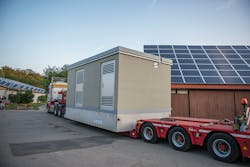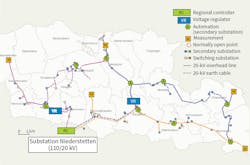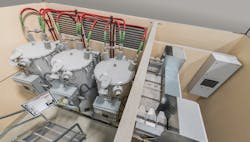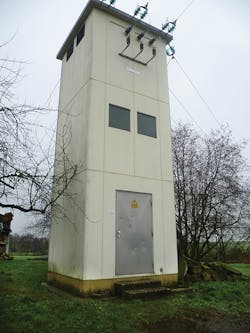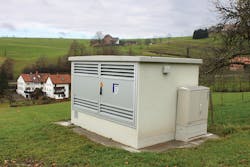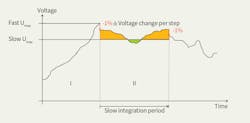Niederstetten is no different from many other towns in southern Germany with a little town center surrounded by several outlying communities, farms and industrial zones. However, a closer look reveals practically every suitable roof in the area is covered by the characteristic blue-black solar panels of small- and medium-scale photovoltaic (PV) installations. In fact, Niederstetten has one of the highest ratios of installed PV power per capita in Germany, averaging 2.3 kW per inhabitant.
While this is good news for the local community and in line with Germany’s desired energy turnaround to install all forms of renewable energy generation, it presents a huge challenge for the distribution system operator, Netze BW, which supplies 2.8 million customers through its low-, medium- and high-voltage networks in southwest Germany. The network currently comprises 328 110/20-kV primary substations and 26,000 20/0.4-kV secondary substations. The 20-kV network consists of 8800 km (5468 miles) of overhead lines and another 20,700 km (12,862 miles) of underground cables.
Together with its strategic partner Siemens, Netze BW has decided on a unique approach to voltage management that maximizes its existing distribution network infrastructure. At the same time, the solution enables the distribution system operator to avoid large-scale network reinforcement and interfering with generation, or changing consumption patterns of customers.
Voltage Management
The existing large population of distributed power sources results in increased voltage levels in the distribution network that has to be managed to comply with European Standard EN 50160, which requires the voltage at the customer’s point of supply to stay within the ±10% limit of the declared voltage. The traditional approach to avoid overvoltage is to install more underground cables, erect overhead lines and establish more secondary substations. However, the current modern concepts now try to include the prosumers to accept conditions that impose a temporary reduction of the generated power or demand-side management.
The Solution
The solution adopted by Netze BW integrates more decentralized power generation into the existing 20-kV network, supplied by the 110/20-kV Niederstetten primary substation, and entails the installation of two three-phase medium-voltage (20-kV) regulators. These regulators are connected to two existing feeder lines with a large number of connected sources of generation. Typically, the installed generation capacity on these two feeders totals 3 MW of wind power and 17.5 MW of PV.
By avoiding the establishment of further 20/0.4-kV secondary substations and investing in network reinforcement, the voltage regulators automatically can adjust the voltage level in their specific feeder in real time. These 20-kV, 8-MW voltage regulators are designed to influence voltage within a ±10% range.
To ensure the specified voltage levels are maintained throughout the distribution network, the voltage regulators are remotely operated by a regional controller that receives voltage measurements from 14 important terminal points in the 20-kV distribution network. These measurements are collected at the 20-kV voltage level or, in some instances, on the low-voltage side of secondary substation transformers.
Distribution Network Upgrades
Numerous secondary substations have been refurbished with the installation of modern gas-insulated 20-kV switchgear (Siemens Type 8DJH), fault passage indicators, remote terminal units (RTUs) and modems. Furthermore, some existing medium-/low-voltage substations were upgraded with additional measuring equipment and communications devices to provide the desired information.
Using a sophisticated regulation algorithm, the regional controller, located in the 110/20-kV primary substation, determines the best step position for each voltage regulator. This setting takes into consideration the measured voltage, current network topology, set points and dead band. The latter is used to avoid too many switching operations that would otherwise prematurely increase the wear on the regulator’s mechanism and cause flicker problems.
The control algorithm also can recognize if measurement values are not available or incorrect. These values are then omitted in the control function. If the connection to one of the voltage regulators is interrupted temporarily, a local backup regulation algorithm kicks in and ensures suitable voltage levels can be guaranteed even in these abnormal situations.
The secondary substations are used not only to measure voltage levels at different points on the network but also to monitor the network’s overall status. Siemens’ new feeder condition monitors are designed to detect earth faults and short circuits on the medium-voltage network. This information is displayed locally at the secondary substation and also transferred to Netze BW’s control center and the innovative regional controller (RC).
The RC uses the information from all the connected feeder condition monitors to determine the likely location of a fault in the 20-kV lines. Subsequently, it can open and reclose the switches in the secondary substations by remote control to isolate the faulty section of the network. While only nine of the 85 secondary substations supplied by the primary substation have this capability, by careful selection of their locations, it is possible to reduce the length of the fault outage time significantly for the majority of customers.
Network Reliability
A network analysis study conducted at the beginning of the project determined the average system interruption index (SAIDI) for the project area would be reduced by two-thirds when the network automation facilities were installed. This reduction was regarded especially beneficial because the German regulator has recently started to place monetary incentives on a high reliability of supply.
Although Germany already has significantly high performance in terms of network outages — with an average of 15 minutes to 20 minutes in loss of supply per customer per year — there is still room for improvement, particularly in the more rural areas supplied by a network with a large percentage of overhead lines. This makes Niederstetten an ideal test region, as some 50% of its 86-km (53-mile), 20-kV feeders are overhead lines that have a reliability index is higher than the German average.
Network Operations
The RC monitors the position of all 20-kV switches in the supervised secondary substations, only operating this switchgear when the distribution network is in the predefined normal configuration, namely when all normally open points are in their standard state. If at least one of the normally open points is closed — for example, for repairs or other changes in the network — the controller and all control algorithms automatically revert into a standby mode to ensure the safety of personnel working on the network.
All components used in this project are Siemens standard devices. Wherever possible, the most up-to-date version (for example, the SICAM feeder condition monitors) has been used, and in some cases, a new configuration of the equipment has been developed. A good example of this practice is provided by the voltage regulators. To be applicable for Germany’s three-phase 20-kV system, three one-phase regulators from the U.S. have been combined in one building, using standard medium-voltage switchgear and the Siemens SICAM CMIC RTU for monitoring and control.
A Solid System
At the beginning of 2016, the final pieces of hardware were installed before the decentralized network intelligence could be put into operation in its final configuration. On completion of commissioning and with all equipment in service, the technologies introduced in the distribution network will be field-tested for one year. This project is designed to demonstrate and showcase the network’s capabilities, providing further opportunities for optimization, especially the voltage control algorithm.
Netze BW is not only interested in proving the general capacity and reliability of this automation solution, the utility also uses advanced measuring equipment to determine more information on the operation of the distribution network. Load-flow recordings and information on power quality are especially interesting as they can be used to optimize future network planning strategies. Because of the increasing amount of power electronics and fluctuating loads in the distribution network, this data will prove helpful and certainly be employed in the design and analysis studies conducted on all the utility’s future projects.
Acknowledgement
The author wishes to acknowledge the technical support and assistance given by Oliver Schroedel of Siemens in the preparation of this article. ♦
Matthias Hennig studied business engineering, specializing in power engineering, and holds an MBA degree. He joined distribution system operator Netze BW in 2011 as a project engineer in the research department, where his main fields of interest were innovative solutions for secondary substations, including regulated transformers, measurement equipment and automation technology. Currently, Hennig is the project manager responsible for the smart grid project in Niederstetten, Germany.
About the Author
Matthias Hennig
project manager
Matthias Hennig studied business engineering, specializing in power engineering and holds an MBA degree. He joined distribution system operator Netze BW in 2011 as a project engineer in the research department, where his main fields of interest were innovative solutions for secondary substations, including regulated transformers, measurement equipment and automation technology. Currently, Hennig is the project manager responsible for the smart grid project in Niederstetten, Germany.
